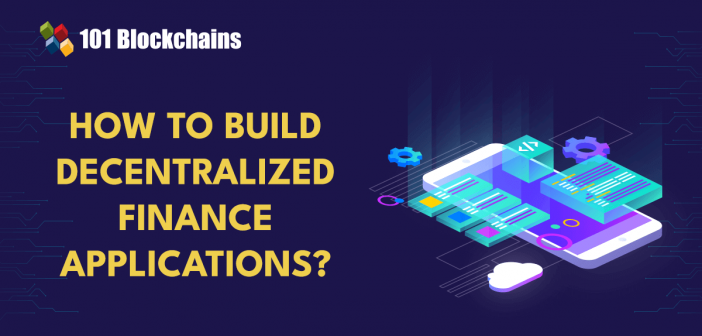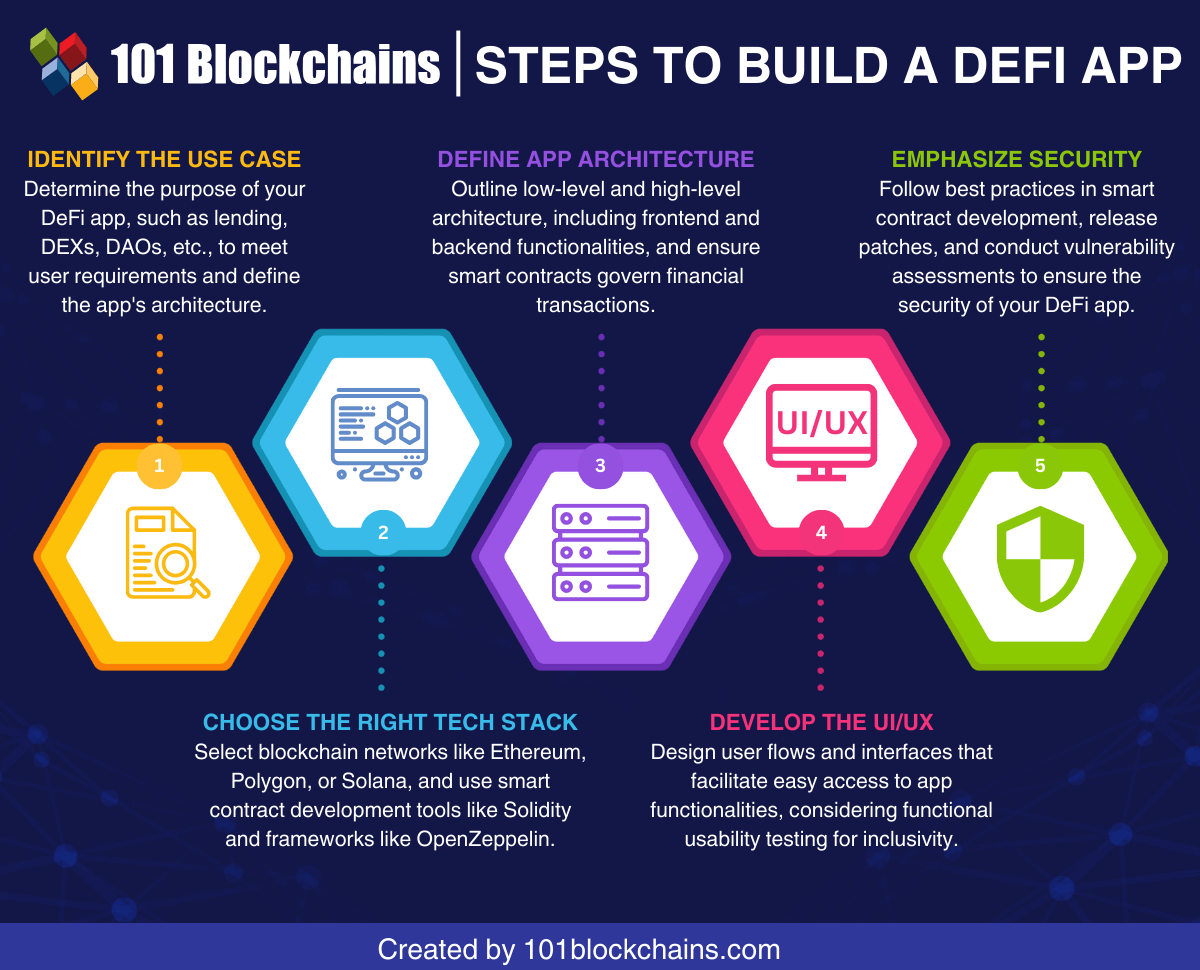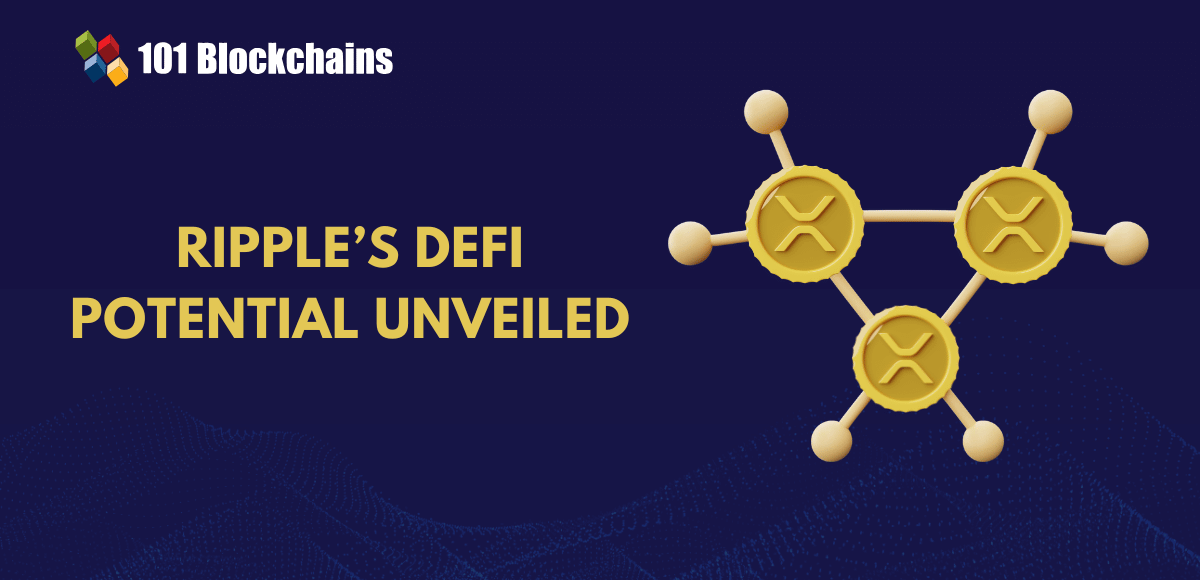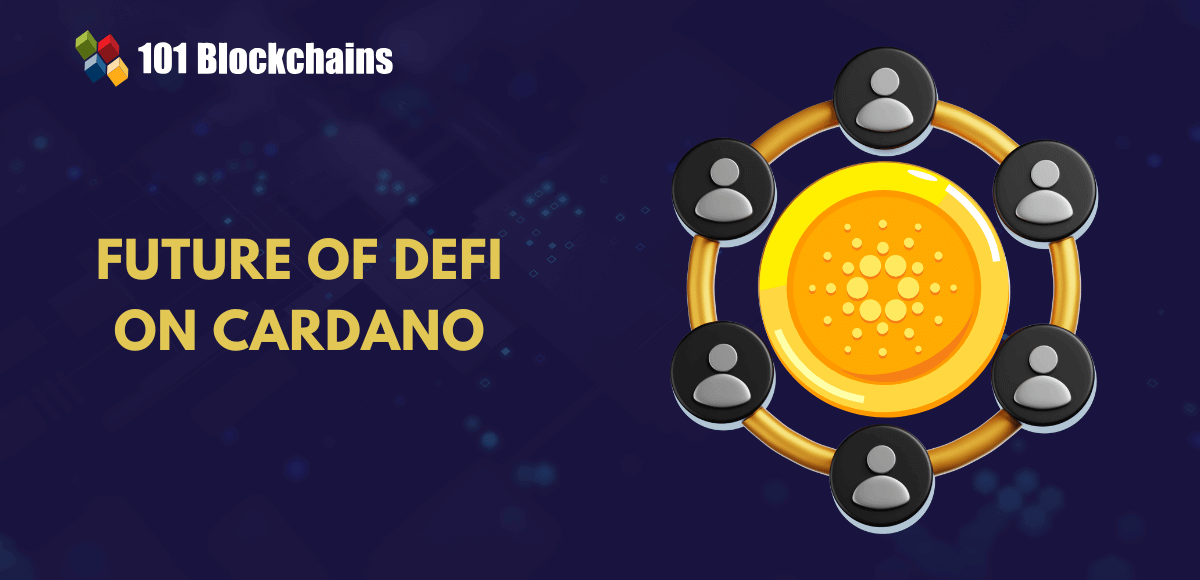Learn how blockchain truly works, master key definitions, and uncover what makes smart contracts so "smart." Dive into the fundamentals, gain valuable insights, and start your blockchain journey today!

- Decentralized Finance
James Howell
- on April 15, 2024
DeFi Development: Guide to Building DeFi Applications
The impact of technology has created a massive impact on different sectors, leading to the arrival of new use cases and trends. Blockchain is one of the top examples of such technologies that have changed different industries. The foremost industry which felt the impact of blockchain is the financial services industry. You are here to learn DeFi application development fundamentals because you know how blockchain has led to the decentralization of financial services. With the help of blockchain, the financial services industry has been moving towards decentralization as it removes the role of a centralized authority. Market reports have suggested that the DeFi market could grow beyond $232 billion by 2030. Businesses want to capitalize on the benefits of DeFi for simplifying financial transactions for their customers.
DeFi, or decentralized finance, has been responsible for the transition of conventional processes in the domain of finance toward decentralized networks. Businesses can build a DeFi app for different reasons, including the development of new financial services solutions and offering new methods for conducting financial transactions. The most interesting thing about DeFi is the broader scope of opportunities associated with it. One of the major objectives of DeFi is the removal of intermediaries and emphasizing technology above everything else. Let us find out how you can build DeFi apps from scratch in the following DeFi development guide.
Enroll now in the DeFi Development Course to understand the best ways to use DeFi development tools like Solidity, React, and Hardhat.
What are DeFi Applications?
One of the first things that you should learn about decentralized finance development is the utility of DeFi apps. Decentralized finance or DeFi points at financial instruments, including services and applications developed on blockchain. DeFi solutions were created as an alternative to the traditional banking sector and to replace traditional financial services with modern technologies with the help of open-source protocols. Decentralized finance works with the help of blockchain technology and smart contracts to offer more transparent and accessible financial solutions. DeFi offers opportunities for interaction with cryptocurrencies, digital assets, and NFTs.
Imagine the possibilities of having a world where financial services are immediately accessible at your fingertips. You don’t have to worry about any central authority directly intervening with your data. The demand for a DeFi development guide has been increasing as more people and businesses want to tap into the potential of DeFi. Decentralized finance utilizes blockchain to offer a borderless approach in the domain of finance. You can take a loan, speculate on price shifts, obtain secure risk insurance, and trade in digital currencies with the help of DeFi.
Learn about DeFi applications and how these work with the presentation on Top 5 DeFi Applications
Important Traits of DeFi Application
DeFi apps work by using blockchain technology, which offers a decentralized network that takes information in the form of blocks. The data blocks or blocks of transactions are chronologically arranged on a chain with the help of timestamps. As a result, the information becomes immutable, and the transactions become irreversible. The responses to “How do I start a DeFi development?” would also suggest that you must know the ways in which blockchain ensures public accessibility of the network. It can ensure the dependability and transparency of transactions associated with DeFi. What are the other aspects that separate DeFi applications from the crowd?
-
Decentralization
Conventional financial frameworks have ruled the domain of finance. You can learn the DeFi development guide to create solutions that can address the setbacks of centralized finance. The most critical setback of centralized finance is the involvement of central entities or institutions in the management and regulation of financial transactions. With the help of decentralization, DeFi apps reduce the dependency on intermediaries. It can help in creating an ecosystem that revolves around the elements of trust and transparency. Users can gain control over their transactions and remove potential setbacks with the help of DeFi.
-
Interoperability
Another important trait of DeFi apps points to interoperability, as DeFi protocols can interact with each other. It could help offer feature sharing, straightforward asset trading, and data exchange. Interoperability opens the doors for developing compound applications in which DeFi protocols can capitalize on the attributes of other protocols. As a result, interoperability empowers the rise of perspectives on developing a tightly knit and diverse DeFi ecosystem.
-
Non-Custodial Control
The next crucial aspect you must understand to build a DeFi app is the assurance of non-custodial control. DeFi applications allow users to have non-custodial control over their assets. It means that users would have complete authority and ownership over their funds in all financial transactions. DeFi apps rely on smart contracts to ensure that users are in control of their assets.
-
Programmability
DeFi applications utilize smart contracts that operate on blockchain networks. Smart contracts serve an important role in the automation of financial transactions and other tasks for DeFi. Developers can use autonomous smart contracts to enable complex financial tasks. In addition, decentralized finance development ensures that all financial operations work seamlessly. Furthermore, smart contracts can also adapt to different types of circumstances and requirements for offering financial services.
-
Liquidity Provision
The list of distinctive traits of DeFi apps also draws attention to the capability of DeFi apps for liquidity provision. DeFi platforms help users in depositing their assets in liquidity pools to obtain reward tokens or interest. The pooled resources facilitate liquidity to the DeFi platforms to enable borrowing and seamless trading operations. With a decentralized approach, the liquidity provision in DeFi apps is considerably different from traditional finance methodologies.
What are the Important Functionalities of DeFi Apps?
The most notable highlight of a DeFi development guide is the description of the functionalities you need in DeFi apps. Apart from the benefits of independence and decentralization, DeFi applications can help in serving a broad range of applications. The use cases of DeFi prioritize the transformation of conventional financial processes. Here is an outline of the different functionalities of DeFi.
-
Stablecoins
Stablecoins represent a stable group of assets in the DeFi landscape. The riskiest trait of any cryptocurrency is the higher volatility, which creates confusion for investors. Stablecoins work by pegging their value to reserve assets, which makes them one of the most revolutionary crypto assets.
-
Tokens
DeFi tokens mined on pre-existing blockchains are also an important aspect you would come across when you learn DeFi development best practices. In addition, DeFi tokens can be pegged against an underlying asset, such as fiat currency or gold.
-
Liquidity Mining
Liquidity mining is also an important highlight in the DeFi ecosystem. Also known as yield farming, it involves the use of cryptocurrencies to facilitate liquidity. For example, decentralized exchanges utilize Automated Market Maker to facilitate effective regulation of trading activities. Users can swap tokens for trading cryptocurrencies in the liquidity pool to earn passive income.
-
Exchange
DeFi exchanges can help users in trading cryptocurrencies without the involvement of third-party intermediaries. The DeFi exchange apps leverage smart contracts to enable peer-to-peer and direct trading.
-
Staking
The functionalities of DeFi also include staking, which utilizes idle coins to support the validation of cryptographic transactions. You must learn that staking is possible with the Proof of Stake consensus that focuses on ownership stake rather than the proof of work.
-
Borrowing and Lending
People who want to find answers to “How do I start a DeFi development?” must also pay attention to the functionalities of borrowing and lending in DeFi apps. DeFi has been creating different alternatives to traditional finance use cases, and lending and borrowing apps are one of the top examples of this. Smart contracts serve as the technological intermediary in such apps, thereby ensuring that the lenders and borrowers follow all the conditions.
-
Wallets
The DeFi ecosystem also includes wallets as one of the notable additions for exploring a different perspective on decentralized finance. Cryptocurrencies are still in the initial stage and need central authorities, such as a digital wallet. Digital wallets are responsible for holding the key in the process of exchanging cryptocurrencies. DeFi wallets could help users exercise complete control over their assets and keys.
Catch up on the latest trends in DeFi and its connection to crypto with Decentralized Finance Skill Path
Steps to Develop a DeFi App from Scratch
The growing popularity of DeFi development has invited attention to the creation of innovative DeFi solutions. You should learn how to build a DeFi app from scratch by following the best practices recommended by experts. Here are some of the essential steps you must follow to create a DeFi app.

Please include attribution to 101blockchains.com with this graphic. <a href='https://101blockchains.com/blockchain-infographics/'> <img src='https://101blockchains.com/wp-content/uploads/2024/04/Steps-to-Build-a-DeFi-App.png' alt='Steps to Build a DeFi App='0' /> </a>
-
Identification of the Use Case
The first step in the process of developing a DeFi app is the identification of the use case. Why do you want to create a DeFi app? DeFi serves a broad range of use cases, including lending and borrowing, DEXs, DAOs, yield farming, and stablecoins. You should establish a niche to develop DeFi apps according to user requirements. Effective identification of the use cases of your DeFi app helps in defining the architecture of the app.
-
Choose the Right Tech Stack
The next crucial highlight in the process of decentralized finance development is the selection of the tech stack. You must pay attention to the selection of crucial components for essential functionalities of the DeFi app. First of all, you must choose the blockchain network on which you have to develop the DeFi app. Ethereum is one of the most popular blockchain protocols for DeFi development. On the other hand, Polygon and Solana have also emerged as notable protocols for developing DeFi apps.
You must also emphasize other aspects such as smart contracts, decentralized storage, development tools, frontend and backend frameworks, and UI development tools. The tech stack to build a DeFi app involves the use of smart contract development tools such as Solidity programming language and development frameworks such as OpenZeppelin, Truffle, Hardhat, and Ganache.
It is also important to pick an alternative for decentralized storage, such as IPFS, that can provide scalable and secure storage. The development tools for DeFi include web3.js and web3.py libraries. On top of it, you would have to rely on frontend development frameworks such as React and backend development frameworks such as NodeJS and Java. DeFi development projects also require database technologies in the tech stack, such as NoSQL, PostgreSQL, and MySQL. You must also emphasize the web3.js or ethers.js frameworks for UI development.
-
Definition of App Architecture
You should provide a clear definition of app architecture after determining the tech stack for DeFi development. Developers seeking answers to “How do I start a DeFi development?” must define the low-level and high-level architecture of DeFi application. In addition, the architecture defines the frontend and backend functionalities alongside offering clarity on how smart contracts ensure governance for financial transactions. You must also outline the functionalities and features that you want in the DeFi app to support desired use cases.
-
Develop the UI/UX
User experience not only focuses on the aesthetics of the app but also on mapping the journey of a user to ensure effective engagement. During the design of UI, developers must consider the ways in which users can access different functionalities and features. Developers must create sketches of user flows to design the ideal user interface of DeFi apps that can help in performing the primary tasks. You must also emphasize functional usability testing to ensure that DeFi apps offer an inclusive experience to all users.
-
Emphasize the Security Posture
The security posture of DeFi apps is one of the biggest concerns for a developer. You have to pay attention to essential best practices for ensuring security as you learn DeFi development. Developers should pay attention to carefully scripting the code for smart contract development. In addition, you must also release the patches for developing intelligent contracts and implementing vulnerability assessments.
Want to explore in-depth about DeFi protocol and its use cases? Enroll now in the DeFi Intermediate Level Course
Final Words
The development of decentralized finance solutions has emerged as a formidable highlight in the cryptocurrency landscape. It is important to understand that decentralized finance development is an essential priority in the emerging web3 landscape. DeFi solutions can offer a decentralized alternative to conventional financial services with multiple value advantages. The conventional approaches to providing financial services have been plagued with a wide range of issues, including censorship and lack of transparency. You can explore diverse use cases of DeFi to create innovative solutions that can transform the financial services landscape. Learn more about the fundamentals of DeFi and discover the ideal path to create your first DeFi solution right away.
*Disclaimer: The article should not be taken as, and is not intended to provide any investment advice. Claims made in this article do not constitute investment advice and should not be taken as such. 101 Blockchains shall not be responsible for any loss sustained by any person who relies on this article. Do your own research!




![30+ Best Decentralized Finance Applications [Updated] best decentralized finance (DeFi) applications](https://101blockchains.com/wp-content/uploads/2020/10/decentralized-finance-applications.png)

